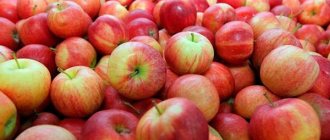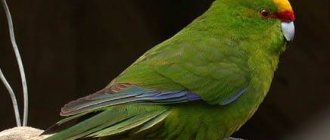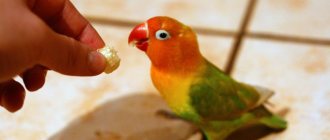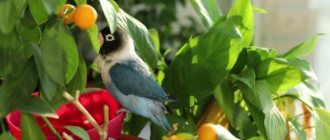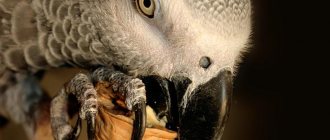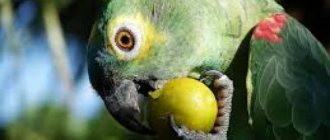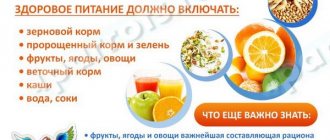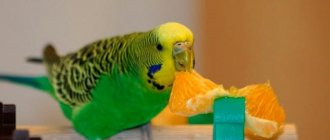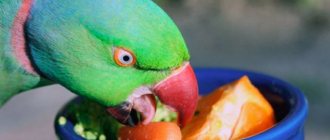Most likely, you, like many other parrot owners, have wondered whether it is possible to give parrots bread.
This question often arises among those people who have recently got themselves a parrot or are planning to do so in the near future.
Some may think that parrots simply do not need bread, some may think that bread is harmful for parrots, while others will think that bread, on the contrary, is good for parrots.
One way or another, you are guaranteed to know the answer to this question if you read the material published in this article.
Ornithologists and veterinarians believe that parrots can be given bread, as it has certain benefits for their body.
However, it is necessary to understand that bread, like all other products, must be consumed in small quantities, and with active consumption of bread alone, health problems can arise for both humans and parrots.
It is imperative to observe the measure so as not to harm the parrot’s body.
- What kind of bread should you not give to your parrot?
- What kind of bread can be given to parrots
Is it possible or not?
Before answering the question of whether it is possible to feed a parrot bread, you need to know the main varieties of this delicacy:
- wheat (white);
- rye (black);
- wheat-rye;
- bran;
- wholegrain.
Two types of bread, different in composition and properties, prevail over others: black and white. I analyzed their effect on the gastrointestinal tract of poultry.
Is it possible to feed a budgie with bread?
White contains wheat flour, yeast, salt and sugar. An industrial product may additionally contain milk, vinegar, vegetable oils and margarine, spices, and chemical additives. Products made from white flour contain mainly starch and a meager amount of vitamins and minerals.
Black bread is made from rye flour, yeast, malt and salt. Such baked goods include many essential amino acids, vitamins B and PP, zinc, manganese, and phosphorus.
Now let's look at how the composition and type of such a product affects the health of our pets.
Every baked goods recipe contains yeast, flour, eggs, sugar, and salt. These spices are poorly digested, which leads to disruption of the microflora in the pet's stomach. This is a double-edged sword. Despite the fact that the composition of bread crumbs has an adverse effect on parrots, it is advisable to include them in the menu. The point lies in the variety and dose that the chick is allowed to peck per day.
What to do if a parrot gets into a bag of bread?
Parrots can be tricky, and when we're not looking, they can sneak into things they shouldn't.
If your parrot gets into your bread, keep a close eye on it. As mentioned earlier, a small amount of bread is unlikely to cause harm. Watch for signs:
- Labored breathing
- Lethargy
- Loss of interest in daily activities
- Loss of appetite
- Litter change
- Excessive thirst
- Lack of energy
- Sneezing
- Dull or plucked feathers
- Blood
- Or any other sign of illness
In other words, monitor your parrot closely for any abnormalities. If you notice anything unusual, call your veterinarian immediately to have them checked.
Can parrots eat black bread?
Despite the composition rich in useful substances, consumption of products made from rye flour by any bird can cause irreparable harm to its health. The reason for this is the high acidity of the product. It causes fermentation processes in the gastrointestinal tract, leading to disruption of microflora, bloating, and exacerbation of helminthic and viral diseases.
This product also contains a lot of starch and salt - substances that are difficult for pets to digest. Their excess amount is not processed by the liver, accumulates in the body, leading to its poisoning and kidney failure. Igor Ignatenko
Due to the abundance of starch and low-molecular dextrins, baked goods made from such cereals swell greatly in the digestive organs of the bird. When consumed, the crumb of rye bread becomes very clogged with the bird's crop (the section into which food enters and where it is practically poisoned), an inflammatory process occurs, and breathing problems arise. Descending lower along the gastrointestinal tract, the sticky mass clogs the patency, causing bloating and volvulus.
I concluded that giving such a treat to feathered pets is prohibited.
What happens if you give your parrot black bread?
Authorized Products
Food of animal origin
Protein feeds are used as an additive to the main food (cereal mixture, fruits, vegetables) to compensate for the lack of certain vitamins and minerals in the body of budgerigars.
Birds need to be fed animal products about two to three times a month. During molting, during the nesting period and when feeding offspring, you need to feed your pets with squirrels much more often - almost every day. Protein foods include the following products:
- egg - high content of vitamins A, D, E, K and microelements: phosphorus, chlorine, iodine and others;
- fish oil is a source of vitamins, iodine, phosphorus;
- cottage cheese is rich in vitamins and various microelements: magnesium, calcium, iron and others.
It is best to give your budgie a chicken egg; it is easier to digest. It needs to be hard-boiled. To do this, you need to keep it in boiling water for about eight minutes. After which the boiled egg is freed from the shell and crushed with a fork or tinder on a grater.
The resulting dish can be given to the bird either in this form or mixed with grated vegetables. For example, with carrots or beets. To make the mixture crumbly, add a small amount of semolina to it. Some birds like it if you add a little food to the egg. No salt!
Fish oil is given to a parrot only if it has a severe lack of calcium in the body. It is sold in pharmacies both in its natural form and with the addition of vitamins A and D. This product requires certain storage conditions: no more than ten degrees Celsius. Therefore, it must be stored in the refrigerator. Remember - if you purchased a bottle of fish oil, its contents deteriorate (oxidize) in two to three days after opening.
If you doubt whether cottage cheese is suitable for budgies, know - only low-fat. Moreover, it must be fresh. If the cottage cheese is not crumbly, add a small amount of semolina to it. Before serving, always taste the cottage cheese - a sour product can poison your pet.
Also, budgies are sometimes given mealworms and gammarus (a small amphipod crustacean) in the form of protein feeding. In the wild, these birds sometimes happily feast on various small insects, so at home such protein food will benefit them.
When preparing animal products, there are several things to consider. Firstly, this is quickly perishable food, especially in the hot season. Therefore, you need to sprinkle food at one feeding and remove it after a while if the parrot has not finished eating. Otherwise, the pet may get poisoned. Secondly, there must be a separate feeder for protein food.
Food of plant origin
We talked about the main plant food (grain mixture) in the article “Food for a budgie.” However, grain is not the only plant product that is given to these pets. For example, you can cook porridge with it. This is an excellent supplemental food that can be included in a bird's daily diet.
Can budgies eat white bread?
Products made from wheat flour do not have such a detrimental effect on the esophagus of a pet. They have much less acidity and contain a minimal amount of chemical additives and salt.
White bread is considered safe for pets. It contains many useful substances:
- 4.5-8% protein;
- 33% essential amino acids;
- 1.5-2% fat;
- 25-30% B vitamins;
- 23-30% minerals.
But the benefits of baking occur when the portions are small and are rarely present on the menu.
This delicacy is porous and fluffy, so it does not irritate the gastrointestinal tract as aggressively as the very sticky crumb of rye bread.
Read also
Waka food for parrots
However, you need to remember about the high content of gluten and starch in the composition, especially in a freshly baked product. Excessive consumption can lead to sticking of the walls of the internal organs of birds.
The low nutritional value of white flour products, when consumed in abundance, can lead to hypovitaminosis D, E, and a lack of manganese in the body. Due to a lack of calcium, the development of rickets, skeletal deformations of young individuals, and decreased egg production in females are possible.
Moderate consumption of the product will not cause much harm to the bird.
Only as a delicacy - but not part of the menu!
It is given exclusively in dried, crushed form. It is better to use crackers as a reward treat during training, or add them to egg and vegetable mash. In the latter case, this increases the friability of the mixture and shelf life. The treat should not have mold, since most forms of it are real poison for birds.
Is it allowed to give crackers?
As mentioned above, fresh bread cannot be given to parrots, because it contains a large amount of gluten. The product should be slightly dried and crushed. Rusks are the safest bread format for birds. It contains a minimum of gluten, even with losses in some nutrients.
If the bird is medium or large in size with the same massive beak, then it is permissible to give the crackers uncrushed. The practicality of crumbs is that they can be combined with dry food. In tandem with grain, the breading is perfectly ground in the crop.
Combination with other products is also practiced:
- Lettuce leaves, cabbage. Has a positive effect on the skin and feathers.
- Watermelon melon. Helps improve immunity due to the abundance of fiber and vitamins C.
- Fruits and berries. A large amount of antioxidants improves your pet's health.
- Legumes. A source of protein as well as energy, which is especially important for young and weakened birds.
Sweet baked goods, even made from wheat flour, are contraindicated for birds. Sugar will destroy the animal's gastrointestinal tract, and in large quantities can lead to death. Therefore, cookies, bagels, buns, etc. should be completely excluded from the parrot's diet. The same goes for foods high in salt.
Porridge for cockatiels
Cooking rules:
- Boil in water.
- Without salt and granulated sugar.
- Cook to the state your cockatiel likes, that is, to a crumbly or viscous porridge.
- You can chop fruits and vegetables, then add them to the porridge after cooking.
Types of cereals suitable for cockatiels:
- oats (oatmeal),
- pearl barley,
- buckwheat,
- rice,
- millet.
Prohibited Products
When feeding your budgie, be sure to take into account the fact that its body is not designed for many of the foods we are accustomed to. After all, poultry digestion is mainly aimed at processing various grains. Here is a list of foods that should absolutely not be given to wavy pets due to their high content of harmful substances:
- milk (cream);
- cheese (especially salty);
- coffee;
- alcoholic drinks;
- potato;
- chocolate;
- fried foods;
- fatty foods;
- salty foods;
- sweet products;
- sausage (sausages);
- meat - in rare cases, you can give the parrot a piece of boiled chicken;
- fruits: avocado, mango, papaya, persimmon;
- spices;
- spinach;
- nuts;
- apple and pear seeds;
- onion;
- garlic;
- mushrooms.
What does your parrot like to eat?
If you liked the article, share it with your friends and like it.
Changing your diet depending on the time of year
In autumn-winter, it is advisable to add young green branches of fruit trees (cherry, plum, apple tree), as well as decorative deciduous trees (rowan, birch or linden) to the parrot’s diet. These twigs contain vitamins and tannins; they will be an excellent addition to green and grain foods.
In winter and spring, it is recommended to treat your pet with pine or spruce needles. The needles can be crushed and added as an additive to the main feed. Alternatively, you can hang a whole branch in a cage. Conifer needles contain a lot of essential oils and resins, and an excess of them can have a detrimental effect on your feathered friend. Remember that the daily intake of pine needles should be about 5% of total food intake. That is why it is necessary to give pine needles no more than 2 times a week.
Choosing a parrot and its adaptation to a new home
It is best to buy a parrot from breeders who have many positive reviews. This way you can be sure that you will get a healthy bird, and the breeders also provide advice on maintenance. Parrots are sold in pet stores, but here you need to be careful. Very often, pet store workers do not have special knowledge about the proper care of animals, and the birds are kept in poor conditions. In addition, it is not clear where the parrots came from in the pet store. When purchasing from a pet store, you need to monitor the quality of the food in the cage, the cleanliness of the tray, and the appearance of the birds. You can ask various tricky questions to the seller to understand how knowledgeable he is about keeping parrots. The riskiest option for buying a parrot is at the bird market. Here you can no longer be sure of the bird’s health.
When purchasing, you need to pay attention to the condition of the parrot's feathers. They should be bright and smooth. The eyes should not be cloudy. The wax and beak should not peel off. The bird must be active and inquisitive. The ideal age to buy a parrot is 6-7 weeks; an older bird will be difficult to tame.
You need to buy a parrot in ready-made conditions. The carrier with the animal can be placed in the cage and wait until the bird gets out. At first, you shouldn’t bother the bird too much. Let the parrot get used to its new home. You can talk to him calmly so that he gets used to your voice. It is advisable to keep the purchased parrot in quarantine from other parrots and pets for a couple of weeks, so as not to infect them if the animal is sick.
The rules for keeping parrots of different species may differ slightly, because they live in different natural conditions and also eat differently. Before purchasing a bird, you need to thoroughly study the basic rules for keeping the selected species. In the right conditions, parrots rarely get sick, but if you notice symptoms of illness in your pet, you should immediately see a doctor.
Thus, we looked at whether parrots can eat bread, how to feed them properly, what kind of cage to buy and how to equip it.
Is there any harm
If a parrot has stomach problems, such as high acidity, then apples should be abandoned in favor of fruits with a more gentle composition: bananas, peaches, plums, etc.
The fruits should also not be given to immature young animals who have not yet begun to eat on their own. It is better to refrain from treating your pet with apple seeds. The seeds contain amygdalin glycoside, which releases toxic substances when processed. They will not cause harm to the body of adults and large individuals, such as cockatoos, macaws or African grays, but small birds - lovebirds or budgerigars - can be poisoned.
Some parrots cannot tolerate certain elements in principle, which is expressed by allergic reactions of various kinds. Therefore, before including apples in the diet, it makes sense to give your pet a small piece to try.
The fruit selection procedure deserves special mention. It often happens that a beautiful-looking and tasty fruit turns out to be a carrier of dangerous substances. And if the human stomach has more or less adapted to pesticides and other chemicals, then the gastrointestinal tract of a bird can cause serious problems, and in difficult cases lead to death.
Key points when choosing apples:
- presence of damage;
- elasticity;
- color;
- size;
- smell.
There should be no dents or dark spots on the surface. If, when you press on the peel, it bends easily, then most likely the apple is not fresh. Too bright colors should immediately alert you. Good fruits have a uniform and non-flashy color.
Better to give up the giants. Large sizes are largely the result of chemicals, not agricultural technology. The best option is a medium-sized apple. The fruits must emit a characteristic aroma for the crop. The abundance of chemicals partially neutralizes the smell, so its absence is a bad sign.
Some people are afraid of radionuclides in apples and GMOs. In fact, these are unfounded fears. Radionuclides accumulate only in the soil, and apples grow on trees. Given the existing varietal diversity, improving apples at the genetic level is simply unprofitable. It is more practical to carry out another selection.
Feed rate per day
The cockatiel is a medium-sized parrot and can eat approximately 30g of food per day. This is the total amount for an adult: 2 teaspoons of grain mixture, succulent food, grass. If the bird does not empty the feeder during the day, you need to reduce the portion. Feed poured in the morning should not be left overnight. It is thrown away, the feeding container is cleaned and a small amount of dry assortment is added before bedtime so that the pet can satisfy its hunger after waking up.
It is quite difficult to feed such a picky bird as a cockatiel. She is also suspicious of colored granules in ready-made mixtures, and unfamiliar fruits, vegetables, and foods with an unusual smell. And yet, an impressive list of what you can feed your cockatiel allows you to create a complete diet, healthy and nutritious.
Is it possible to feed a cockatiel nuts?
Certainly. But there are some nuances here. Crushed nuts are suitable for parrots. They should also not be pre-fried. Give preference:
- hazelnuts,
- peanuts,
- walnuts.
The daily diet of cockatiels should contain no more than 10% of nuts. This is explained by the fact that this product is very rich in proteins and fats. Therefore, you can’t use it a lot.
Cell selection
The size of the cage depends on the size of the parrot you choose to keep. Cages for cockatiels and budgies should be between 45 × 45 × 60 cm in size. It is advisable to have a tray in the cage to make cleaning easier. You can lay paper towels on it or pour special sand. The cage should have wooden perches made from fruiting tree varieties. A drinking bowl for the parrot and two feeders (for dry and wet food) should be attached to the rods. You can attach various entertainment and toys that are sold in pet stores.
Place the cage in a place away from drafts and away from direct sunlight. A place far from the TV and speakers, where there is no vibration or noise and where other pets cannot reach. The room temperature should be kept around 18-20 degrees.
From time to time, your pet parrot should be allowed to fly around the room.
What should you always do when feeding your cockatiel?
- Monitor the amount of food your bird eats.
- Give clean, fresh water every day.
- Feed your cockatiel a variety of fresh foods, fruits, and vegetables daily.
- Wash feeders and drinkers every day, change food and water.
Some foods that can be offered to your cockatiel are: apple, cherry, pear, apricots, peas, asparagus, coconut, banana, corn, pineapple, beans (cooked), cucumber, plum, dandelion, leaves, pomegranate, bud, dates, potatoes, lentils, pumpkin, figs, grapes, raspberries, grapefruit, rice (brown), soy, cabbage, lettuce, beets, kiwi, spinach, blueberries, melon, sprouted seeds, broccoli, mango, pumpkin, Brussels sprouts, nectarines, strawberries, cabbage , orange, melon, papaya, tomato, carrots, peaches.
